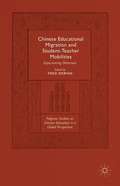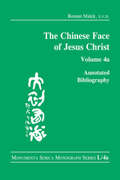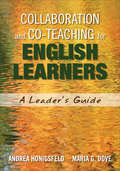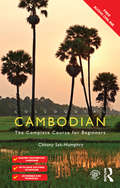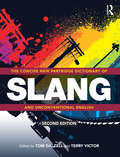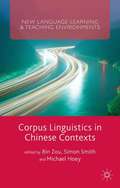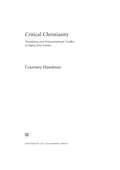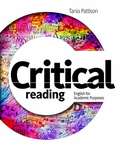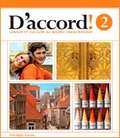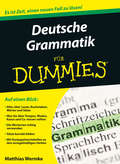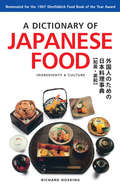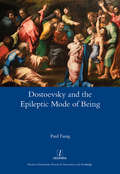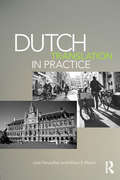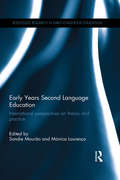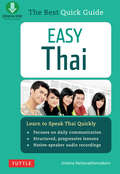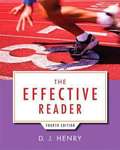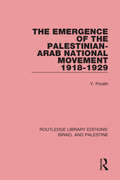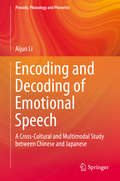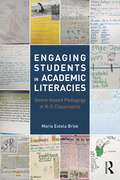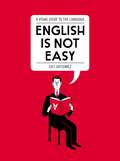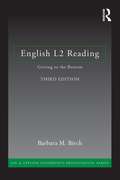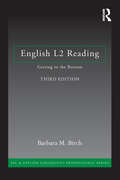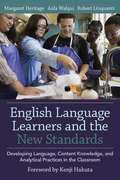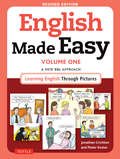- Table View
- List View
Chinese Educational Migration and Student-Teacher Mobilities
by Fred DervinChina has awakened but is international education ready? Chinese students, teachers and staff are now familiar faces in universities around the world and this original volume examines their multifaceted experiences in Australia, Denmark, France, Japan, the UK and the US. The authors propose case studies that will appeal to an international audience interested in one of the most mobile populations in global Higher Education. By doing so they question some of the assumptions and misleading facts about Chinese students, teachers and staff abroad. This volume will serve both as a solid introduction and as a thorough review for more knowledgeable readers.
The Chinese Face of Jesus Christ: Annotated Bibliography: volume 4a (Monumenta Serica Monograph Ser.)
by Roman MalekThis volume provides an annotated bibliography of the Western and Chinese literature on Jesus Christ in China. It is a sequel to the interdisciplinary collection on the manifold faces and images of Jesus throughout Chinese history, from the Tang dynasty (618�907) to the present time.The present bibliography broadens and deepens the above-mentioned subject matter, and also points out aspects which have been addressed in the contributions and anthologies of the previous volumes of The Chinese Face of Jesus Christ, but which have not been treated thoroughly. Another aim of this bibliography is to initiate and enable further research, particularly in China. It includes bibliographical data from the beginning of the introduction of Christianity to China until the year 2013, occasionally also until 2014. A list of �Key References� enables the reader to identify important works on main topics related to Jesus Christ in China. Some examples of book covers and title pages are included in the section of �Illustrations.�Other volumes of the collection The Chinese Face of Jesus Christ are in preparation: Vol. 3c will present longer quotations from the sources listed in the present bibliography, Vol. 4b will contain a general index with glossary, and Vol. 5 will deal with the iconography of Jesus Christ in China.
Collaboration and Co-Teaching for English Learners: A Leader's Guide
by Andrea M. Honigsfeld Maria G. DoveYour English Language Learners are counting on you to collaborate effectively. The Common Core State Standards have increased the pressure on English Language Learners. And with the EL population increasing every day, schools need proven systems for ensuring that the students of the future are able to thrive. In practice, this is a challenge for educational leaders. The most promising solution is the collaborative approach pioneered by this book’s authors—America’s leading authorities on collaboration and co-teaching for EL achievement. Honigsfeld and Dove’s resources for collaboration and co-teaching include Templates for creating EL profiles that will enable you to address their unique needs Prompts for Professional Learning activities (for teams or individuals) and further reading The latest research findings on best instructional practices that benefit ELs This is your concise, comprehensive guide to creating a powerful collaborative program to benefit your ELs. Start implementing it today and watch the outcomes improve.
Collaboration and Co-Teaching for English Learners: A Leader's Guide
by Andrea M. Honigsfeld Maria G. DoveYour English Language Learners are counting on you to collaborate effectively. The Common Core State Standards have increased the pressure on English Language Learners. And with the EL population increasing every day, schools need proven systems for ensuring that the students of the future are able to thrive. In practice, this is a challenge for educational leaders. The most promising solution is the collaborative approach pioneered by this book’s authors—America’s leading authorities on collaboration and co-teaching for EL achievement. Honigsfeld and Dove’s resources for collaboration and co-teaching include Templates for creating EL profiles that will enable you to address their unique needs Prompts for Professional Learning activities (for teams or individuals) and further reading The latest research findings on best instructional practices that benefit ELs This is your concise, comprehensive guide to creating a powerful collaborative program to benefit your ELs. Start implementing it today and watch the outcomes improve.
Colloquial Cambodian: The Complete Course for Beginners (New Edition) (Colloquial Series)
by Chhany Sak-HumphryColloquial Cambodian provides a step-by-step course in Cambodian as it is written and spoken today. Colloquial Cambodian has been developed by a linguist and an experienced Cambodian language professor and combines an accessible approach with a thorough treatment of the language, equipping learners with the essential skills needed to communicate confidently and effectively in Cambodian in a broad range of situations. No prior knowledge of the language is required. Key features include: progressive coverage of speaking, listening, reading, and writing skills jargon-free explanations of grammar an extensive range of focused and stimulating exercises realistic and entertaining dialogues covering a broad variety of scenarios coverage of the Cambodian writing script useful vocabulary lists throughout the text additional resources available at the back of the book, including a full answer key, a grammar summary, bilingual glossaries, and translations of dialogues and reading passages. Balanced, comprehensive, and rewarding, Colloquial Cambodian is an indispensable resource both for independent learners and for students taking courses in Cambodian. Accompanying audio material is available for free download from www.routledge.com/9780415524070 in MP3 format. Recorded by native speakers, the audio complements the book and will help enhance learners’ listening and speaking skills.
The Concise New Partridge Dictionary of Slang and Unconventional English
by Tom Dalzell Terry VictorThe Concise New Partridge Dictionary of Slang and Unconventional English presents all the slang terms from The New Partridge Dictionary of Slang and Unconventional English in a single volume. Containing over 60,000 entries, this concise new edition of the authoritative work details the slang and unconventional English of from around the English-speaking world since 1945, and through the first decade of the new millennium, with the same thorough, intense, and lively scholarship that characterized Partridge’s own work. Unique, exciting and, at times, hilariously shocking, key features include: unprecedented coverage of World English, with equal prominence given to American and British English slang, and entries included from Australia, New Zealand, Canada, India, South Africa, Ireland, and the Caribbean emphasis on post-World War II slang and unconventional English dating information for each headword in the tradition of Partridge, commentary on the term’s origins and meaning. New to this second edition: a new preface noting slang trends of the last eight years over 1,000 new entries from the US, UK and Australia, reflecting important developments in language and culture new terms from the language of social networking from a range of digital communities including texting, blogs, Facebook, Twitter and online forums many entries now revised to include new dating and new glosses, ensuring maximum accuracy of content. The Concise New Partridge Dictionary of Slang and Unconventional English is a spectacular resource infused with humour and learning – it’s rude, it’s delightful, and it’s a prize for anyone with a love of language.
Corpus Linguistics in Chinese Contexts (New Language Learning and Teaching Environments)
by Simon Smith Bin Zou Michael HoeyRapid advances in computing have enabled the integration of corpora into language teaching and learning, yet in China corpus methods have not yet been widely adopted. Corpus Linguistics in Chinese Contexts aims to advance the state of the art in the use of corpora in applied linguistics and contribute to the expertise in corpus use in China.
Critical Christianity: Translation and Denominational Conflict in Papua New Guinea
by Courtney HandmanIn Critical Christianity, Courtney Handman analyzes the complex and conflicting forms of sociality that Guhu-Samane Christians of rural Papua New Guinea privilege and celebrate as "the body of Christ. ” Within Guhu-Samane churches, processes of denominational schism-long relegated to the secular study of politics or identity-are moments of critique through which Christians constitute themselves and their social worlds. Far from being a practice of individualism, Protestantism offers local people ways to make social groups sacred units of critique. Bible translation, produced by members of the Summer Institute of Linguistics, is a crucial resource for these critical projects of religious formation. From early interaction with German Lutheran missionaries to engagements with the Summer Institute of Linguistics to the contemporary moment of conflict, Handman presents some of the many models of Christian sociality that are debated among Guhu-Samane Christians. Central to the study are Handman's rich analyses of the media through which this critical Christian sociality is practiced, including language, sound, bodily movement, and everyday objects. This original and thought-provoking book is essential reading for students and scholars of anthropology and religious studies.
Critical Reading: English for Academic Purposes
by Tania PattisonCritical Reading provides a systematic introduction to the process of analyzing and evaluating a written text. Students develop critical reading skills through analysis of texts from authentic sources (journals, newspapers, magazines, and websites) and a variety of academic dsiciplines. They are encouraged to develop their comprehension and vocabulary skills, while forming a reasoned assessment of the effectiveness and validity of a text.
Deutsche Grammatik für Dummies (Für Dummies)
by Matthias WermkeIhr Wegweiser durch den Dschungel der deutschen Grammatik Mögen Sie Grammatik? Nein? Grämen Sie sich nicht. Sie sind nicht allein. Irgendwann wurden wir alle mit der Grammatik des Deutschen geplagt. Wir mussten Wörter rauf- und runterdeklinieren, absonderliche Verbformen bilden, Schachtelsätze in ihre Einzelteile zerlegen und nach Satzbausteinen suchen, die uns überhaupt nicht interessierten. Grammatik kann zwar wirklich ätzend sein, nützlich ist sie gelegentlich aber auch. Und damit die deutsche Grammatik für Sie eher nützlich als ätzend ist, finden Sie in diesem Buch die wichtigsten Themen leicht verständlich erklärt, jede Menge Beispiele, die Ihnen die Regeln veranschaulichen und viel Wissenswertes rund um die deutsche Grammatik und deren Bedeutung. Für den schnellen Überblick gibt es zahlreiche Tabellen. So verlieren die vielen Regeln ihren Schrecken und werden auch für Grammatikmuffel leicht verständlich.
A Dictionary of Japanese Food: Ingredients & Culture
by Richard HoskingNominated for the Glenfiddich Food Book of the Year Award, this timeless volume is the first and only book of its kind on the subject.<P><P>A Dictionary of Japanese Food helps food lovers around the world decipher the intricacies and nuances of Japanese cooking and its ingredients. Definitions in ordinary cookbooks and standard dictionaries--such as akebia for akebi, sea cucumber for namako, plum for ume--can be inadequate, misleading, or just plain wrong. Richard Hoskings eliminates the mystery by ensuring that each entry in the Japanese-English section includes the Japanese term in Roman script; the term in kana or kanji or both; a Latin name where appropriate; an English definition; and, for most entries, a short annotation.The English-Japanese section defines important English food terms in Japanese and annotates those needing explanation. One hundred small line drawings make it easy for readers to identify everything from mitsuba to the okoze fish, and seventeen appendices address the most critical elements of Japanese cuisine, from the making of miso and the structure of the Japanese meal to the tea ceremony.
Dostoevsky and the Epileptic Mode of Being
by Paul FungFor Fyodor Dostoevsky (1821-81), who lived with epileptic seizures for more than thirty years, illness is an ineradicable part of existence. Epilepsy in his writings denotes both a set of physical symptoms and a state of survival in which the protagonists incessantly try to articulate, theorize, or master what is ungraspable in their everyday experience. Their attempts to deal with what they cannot control or comprehend results in disappointment, or what Dostoevsky called a mystical terror. Dostoevsky's heroes are unable fully to understand this state, and their existence becomes 'epileptic' in so far as self-knowledge and self-coincidence are never achieved. Fung explores new critical pathways by reexamining five of Dostoevsky's post-Siberian novels. Drawing on insights from writers including Benjamin, Blanchot, Freud, Lacan and Nietzsche, the book takes epilepsy as a trope for discussing the unspeakable moments in the texts, and is intended for students and scholars who are interested in the subject of modernity, critique of the visual, and dialogues between philosophy and literature. Paul Fung is Assistant Professor in English at Hang Seng Management College, Hong Kong.
Dutch Translation in Practice
by Jane Fenoulhet Alison MartinDutch Translation in Practice provides an accessible and engaging course in modern Dutch translation. Taking a highly practical approach, it introduces students to the essential concepts of translation studies, heightens their awareness of the problems posed in Dutch translation, and teaches them how to tackle these difficulties successfully.? Featured texts have been carefully chosen for their thematic and technical relevance, and a wide range of discursive and grammatical issues are covered throughout.? Features include: Nine chapters reflecting different areas of contemporary life and culture in Belgium and the Netherlands? such as People and Places, Dutch Language and Culture, Literature, Employment, Finance and Economics, Media and Communications, Art History and Exhibitions, Fashion and Design and the Earth, Energy and the Environment Authentic extracts drawn from up-to-date Dutch texts used throughout to illustrate and practise various topical and translation issues, with many supporting exercises and open translation activities to encourage active engagement with the material, the? development of strong translation skills, and vocabulary acquisition Chapters structured to provide progressive learning, moving from an introductory section explaining the context for the texts to be translated to information on translation techniques, detailed close readings and analyses of words, phrases, style, register and tone A strong focus throughout on addressing issues relevant to contemporary Dutch translation, with practical tips offered for translating websites, dealing with names and handling statistics and numbers in translation Attention to language areas of particular difficulty, including translating ‘er’, passive constructions, punctuation, conjunctions and separable verbs Helpful list of grammatical terms, information on useful resources? for translators and sample translations of texts available at the back of the book Written by experienced instructors and extensively trialled at University College London, Dutch Translation in Practice will be an essential resource for students on upper-level undergraduate, postgraduate or professional courses in Dutch and Translation Studies.
Early Years Second Language Education: International perspectives on theory and practice (Routledge Research in Early Childhood Education)
by Mónica Lourenço Sandie MourãoThe age for early language learning has dropped dramatically in the past decade to include children under 6 years old, yet very little published research exists to support the implementation of such programmes. Drawing on a synthesis of theory, research and practice, this edited volume makes an innovative contribution to literature concerning language education for very young children. It explores language learning in a wide range of geographical contexts with reference to second and foreign language learning, bilingualism and plurilingualism with children under the age of 6 years old. Chapters present discussion around teacher education, policy-making, international case studies, school and home-based projects, code switching and language use, and methodologies and approaches. Early Years Second Language Education: International perspectives on theory and practice will be essential reading for researchers, academics, teacher trainers, and post-graduate students in the fields of early years education, foreign and second language education, language didactics and teacher education.
Easy Thai
by Jintana RattanakhemakornLearn the basics of Thai quickly and easily! Easy Thai is exciting and helpful for beginning Thai Language students and anyone who needs a functional day-to-day grasp of colloquial Thai. An excellent resource to learn Thai, its twelve chapters cover practical and useful conversation topics such as introductions, telling the time, directions, ordering food and shopping. Each chapter opens with a dialogue that introduces new language in context, and contains: Vocabulary lists Grammar notes Sentence patterns Exercises Notes on culture and etiquette. All dialogues, vocabulary lists, and sentence patterns are rendered in Thai script, romanized Thai, and English. In the comprehensive, concise introduction to Easy Thai, you will understand how to pronounce, read and write the Thai language. A bilingual dictionary at the end of the book gives translations for approximately 1,000 common words in both Thai and English. An audio disc provides sample conversations by native Thai speakers, helping you to practice authentic pronunciation. Easy Thai contains everything you as a beginning language learner need to know about the basics of Thai, making you a more effective communicator from the very first lesson without having to resort to long, dull, expensive courses of study!
The Effective Reader
by D. J. HenryThe author integrates reading skills with the reading process (SQ3R) to produce more effective readers and lead students to discover the power and pleasure of reading. Providing step-by-step reading instruction, a wide range of practice and test materials, and a rich selection of readings from textbooks and other sources, the author makes students responsible for their reading–improving their major reading skills while developing a system for reading.
The Emergence of the Palestinian-Arab National Movement, 1918-1929 (RLE Israel and Palestine)
by Yehoshua PorathThe resurgence of Palestinian nationalism in the wake of the 1967 Arab-Israeli war tended to overshadow the fact that Palestinian national consciousness is not a new phenomenon, but traces its origins back to the time when the first stirrings of nationalism were being felt in many parts of the under-developed world. This work, first published in 1974, is based on both Arabic and Hebrew primary sources as well as English and French official and unofficial documents, and was the first detailed study of the infancy period of Palestinian nationalism. The book begins by establishing the position of Palestine and Jerusalem in Islamic history and their significance within the concepts of Islam, and outlines the social and political features of the Palestinian population at the beginning of the First World War. The author then charts in detail the development of Palestinian nationalism over the decade after the War. Two major forces influenced this development and reacted with it: Zionism, with its ambitious schemes for settling Jews in Palestine and creating a National Home for them there, and Arab nationalism on a wider scale, which was emerging spontaneously with the disintegration of the Ottoman Empire and the spreading of ideas of self-determination. The growing threat posed by Zionism awoke the Palestinian population to the need for organization and the establishment of their own identity to oppose it, while the focus of their national aspirations widened or narrowed according to the ability which they felt at any given time to confront Zionism and achieve self-expression within a Palestinian rather than an all-Syrian national framework. The events of these turbulent years – the confrontations with the British, delegations, boycotts, proposals and rejections, the emergence of al-Hajj Amin al-Husayni, the Wailing Wall conflict and its repercussions – are all described within the context of these wider considerations, which also include Britain’s own role as holder of the Mandate over Palestine.
Encoding and Decoding of Emotional Speech
by Aijun LiThis book addresses the subject of emotional speech, especially its encoding and decoding process during interactive communication, based on an improved version of Brunswik's Lens Model. The process is shown to be influenced by the speaker's and the listener's linguistic and cultural backgrounds, as well as by the transmission channels used. Through both psycholinguistic and phonetic analysis of emotional multimodality data for two typologically different languages, i. e. , Chinese and Japanese, the book demonstrates and elucidates the mutual and differing decoding and encoding schemes of emotional speech in Chinese and Japanese.
Engaging Students in Academic Literacies: Genre-Based Pedagogy for K-5 Classrooms
by María Estela BriskThe Common Core State Standards require schools to include writing in a variety of genres across the disciplines. Engaging Students in Academic Literacies provides specific information to plan and carry out genre-based writing instruction in English for K-5 students within various content areas. Informed by systemic functional linguistics—a theory of language IN USE in particular ways for particular audiences and social purposes—it guides teachers in developing students’ ability to construct texts using structural and linguistic features of the written language. This approach to teaching writing and academic language is effective in addressing the persistent achievement gap between ELLs and "mainstream" students, especially in the context of current reforms in the U.S. Transforming systemic functional linguistics and genre theory into concrete classroom tools for designing, implementing, and reflecting on instruction and providing essential scaffolding for teachers to build their own knowledge of its essential elements applied to teaching, the text includes strategies for apprenticing students to writing in all genres, features of elementary students’ writing, and examples of practice.
English Is Not Easy: A Visual Guide to the Language
by Luci GutiérrezA cheeky, sophisticated, and strikingly illustrated guide that leaves generic English reference books in the dust When prominent Barcelona-based illustrator Luci Gutiérrez found herself tuning out in English class, she used her love of drawing to help retain what she’d learned. Ditching the kind of bland and useless phrases that fill most English textbooks, Gutiérrez uses whimsical characters, cheeky dialogue, and even insults to bring vocabulary, grammar, and usage topics to life. Nearly forty-seven million people in the United States speak a language other than English at home, and even most native speakers struggle with subtle distinctions, such as when to use “whether” as opposed to “if.” (For example: I wonder whether I should have added a little more poison to his tea.) Already published to wide acclaim abroad, English Is Not Easy is sure to delight grammar mavens and students of English in America.
English L2 Reading: Getting To The Bottom
by Barbara M. BirchEnglish L2 Reading, Third Edition offers teachers research-based insights into bottom-up skills in reading English as a second language and a solid foundation on which to build reading instruction. Core linguistic and psycholinguistic concepts are presented within the context of their application to teaching. The goal is to balance or supplement (not replace) top-down approaches and methodologies with effective low-level options for teaching English reading. The text's pedagogical features-- Questions, Study Guide Questions. Discussion Questions, Spotlight on Teaching sections-- engage readers of the text in moving easily from linguistic details and psycholinguistic data and theory to practical explanations and suggestions for teaching. Two Appendices provide tables that list the graphemes or the phonemes of English.
English L2 Reading: Getting to the Bottom
by Barbara M. BirchEnglish L2 Reading, Third Edition offers teachers research-based insights into bottom-up skills in reading English as a second language and a solid foundation on which to build reading instruction. Core linguistic and psycholinguistic concepts are presented within the context of their application to teaching. The goal is to balance or supplement (not replace) top-down approaches and methodologies with effective low-level options for teaching English reading. The text’s pedagogical features— Questions, Study Guide Questions. Discussion Questions, Spotlight on Teaching sections— engage readers of the text in moving easily from linguistic details and psycholinguistic data and theory to practical explanations and suggestions for teaching. Two Appendices provide tables that list the graphemes or the phonemes of English. Changes in the Third Edition Shift in focus from criticism of whole language methodologies to a more neutral stance —times have changed and the study of lower-level reading strategies is now mainstream Greater focus on linguistic form, along with function and meaning Updated information about reading strategies at each level of the reading process More Spotlight on Teaching sections, one for each chapter New chapter on spelling development
English Language Learners and the New Standards: Developing Language, Content Knowledge, and Analytical Practices in the Classroom
by Margaret Heritage Aída Walqui Robert LinquantiIn English Language Learners and the New Standards, three leading scholars present a clear vision and practical suggestions for helping teachers engage ELL students in simultaneously learning subject-area content, analytical practices, and language. This process requires three important shifts in our perspective on language and language learning—from an individual activity to a socially engaged activity; from a linear process aimed at correctness and fluency, to a developmental process, focused on comprehension and communication; and from a separate area of instruction to an approach that embeds language development in subject-area activities. In English Language Learners and the New Standards, the authors:Clarify the skills and knowledge teachers need to integrate content knowledge and language developmentShow how teachers can integrate formative assessment in ongoing teaching and learningDiscuss key leverage points and stress points in using interim and summative assessments with ELLsProvide classroom vignettes illustrating key practicesFinally, the authors explain the theories and research that underlie their vision and examine the role of policy in shaping pedagogy and assessment for ELL students.
English Made Easy Volume One: 1
by Jonathan Crichton Pieter KosterThis is a fun and user-friendly way to learn EnglishEnglish Made Easy is a breakthrough in English language learning-imaginatively exploiting how pictures and text can work together to create understanding and help learners learn more productively. <P><P> It gives beginner English learners easy access to the vocabulary, grammar and functions of English as it is actually used in a comprehensive range of social situations. Self-guided students and classroom learners alike will be delighted by the way they are helped to progress easily from one unit to the next, using a combination of pictures and text to discover for themselves how English works. The pictorial method used in this book is based on a thorough understanding of language structure and how language is successfully learned. The authors are experienced English language teachers with strong backgrounds in language analysis and language learning.English Made Easy, Volume 1 consists of a total of 20 units arranged in groups of five. The first four units presents language and provide learners the opportunities to practice as they learn. The first page of each unit has a list of all the words and phrases to be learned in that unit, together with pronunciation guide. At the end of each unit, an interesting story which uses the language that has just been learned is presented. The fifth unit in each group contains exercises designed to reinforce the language learned in the first four units.
